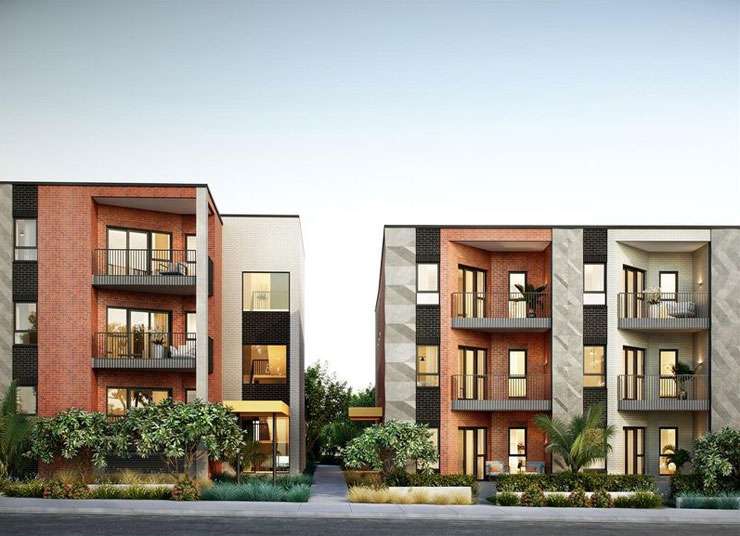Buying a new home has many benefits for homeowners and investors. They take time to build, however. Many factors affect the build time.
A single-level standalone home on a greenfields site is a very different build proposition to a 200 apartment complex, for example.
The construction time is the easy thing to predict, says Grant Florence, chief executive of the New Zealand Certified Builders association. The build of a standalone home on a section should take about 20 to 24 weeks. John Tookey, professor of Construction Management at AUT, concurs.
Homes built that fast are mostly likely to be in suburbs where developers have a stream of consents going through council and have construction teams in and around site already, says Tookey.
Start your property search
A terrace development should take around nine months to complete while an apartment block could take a year or two. By way of example, Ockham Residential’s most recent development, the three-building, 95-unit Kōkihi complex in Auckland’s Waterview, broke dirt in March 2020, four days before the first lockdown, and received its code of compliance certificate in June this year - that’s 15 months later but still four months ahead of schedule. Each development has its own quirks. Kōkihi had extra engineering challenges, thanks to its proximity to the Waterview Tunnel.

An artist's impression of the Kōkihi apartment development in Auckland's Waterview. Photo / Supplied
Everyone has heard of a build that seemed to stretch on forever. It’s what happens before the first spade hits the ground that can make build times as long as the proverbial piece of string, says Florence. That’s largely to do with developers needing to make sufficient pre-sales to get their finance, planning and council consents.
Some of the factors include:
- Pre-sales: Your build may not even start until the developer has pre-sold a certain number of units. Lenders require developers to make a certain number of pre-sales before providing finance for the build. That can take months.
- Design complexity: A simple design will be faster to build than a complex one, says Florence. Likewise, managing the build yourself can slow things down, he says.
- Availability of builders: New Zealand’s skills shortage has been exacerbated by the pandemic. The country is short of around 40,000 tradies, which means many construction companies can’t build as fast as they’d like to, says Florence.
- Supply chain issues: Builders often have difficulty buying materials. New Zealand is a long distance from most of the rest of the world and is a small market. That, combined with the pandemic, has created long delays in the supply chain.
- Council consent: Consenting issues often cause delays to building projects. The best-case scenario is that your consent is turned around in 20 working days, says Tookey. That requires you to be very assiduous at dotting all your Is and Ts before you lodge your initial application. Every time there is a request for more information from the council, the clock resets. If your plans change and you need to amend the consent after it has been granted, the council can add another 20 days to the process. Since 2011 the number of housing consents has grown year on year on average by 13 per cent a year, says Tookey. Councils have not expanded staffing to match, which means they’re trying to eke more consents out of the same number of employees.

Builders on a construction site. Availability of labour will have an impact on build time. Photo / Getty Images
- Height of the building: It takes longer to build a 10-storey apartment building than a two- or three-storey terrace, or simply a standalone home on a greenfields site. Apartment buildings need big cranes and a huge amount of structural work. Most terrace homes are more than one-storey high and have adjoining walls with neighbouring houses. Typically, the entire block will be built at once, not just one terrace at a time. This extends the build time, says Florence.
- Site preparation: Will your site need complex work on the land, drainage, foundations, and earthworks before the build can start? Steep, awkward sites will take longer to build on. If you’re rebuilding on a site where a previous house stood, expect to run into problems such as the need for additional ground reinforcing or new retaining walls, says Tookey.
- Time of the year: The weather may affect your build. Ones taking place during winter usually take longer than the summer. Bad weather can force tradies offsite or indoors. Even the holidays can slow the build down. Tradies take holidays too, especially over December and January.
If you’re lucky your developer and builder will be well down the track of sales, consents and even possibly construction by the time you sign the sale-and-purchase agreement. This will reduce the time until you can move in.
The fastest and least complex way to buy a new home is to find a “turnkey” property that is already built that you can simply buy, turn the key in the lock and move into.















































































